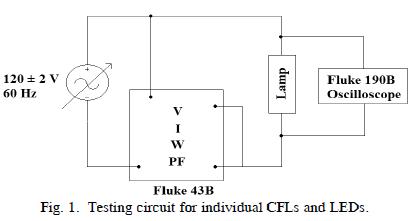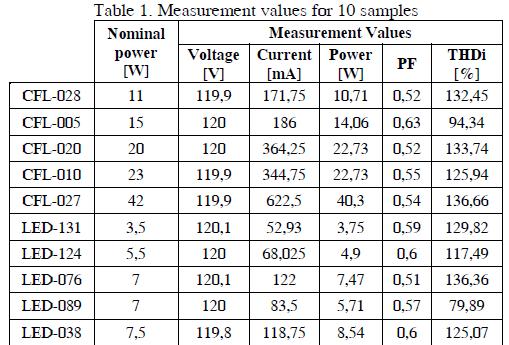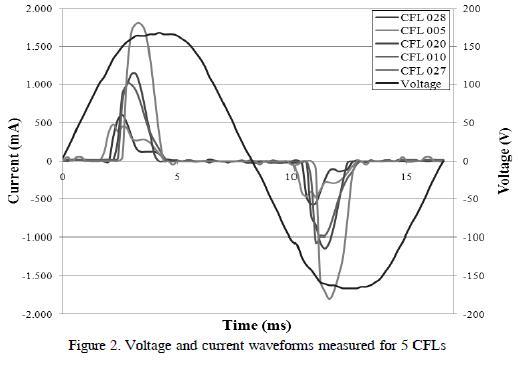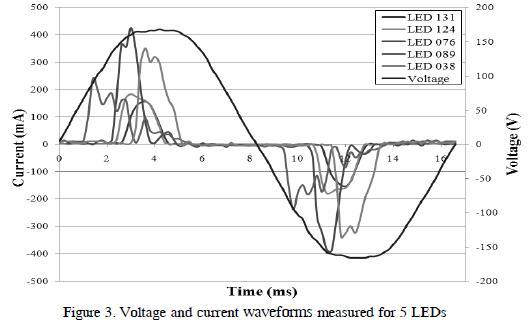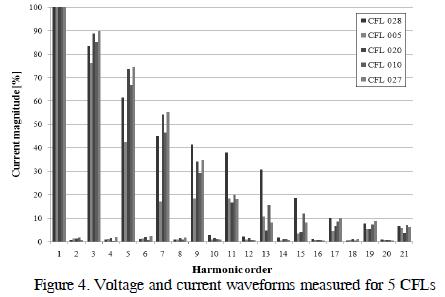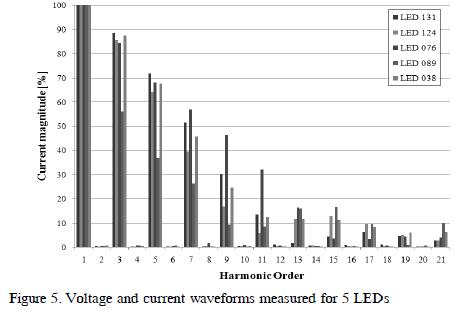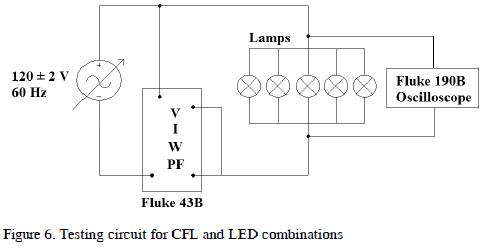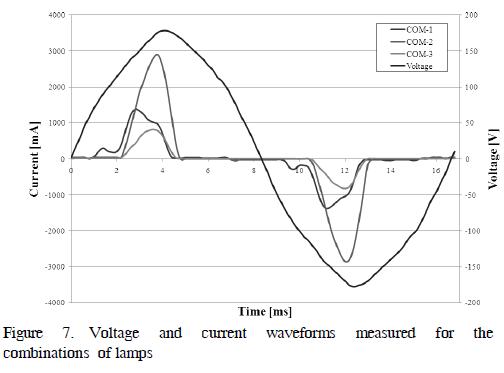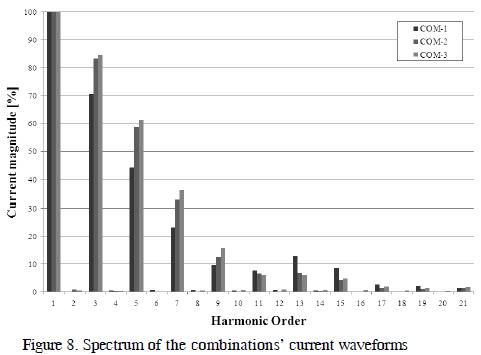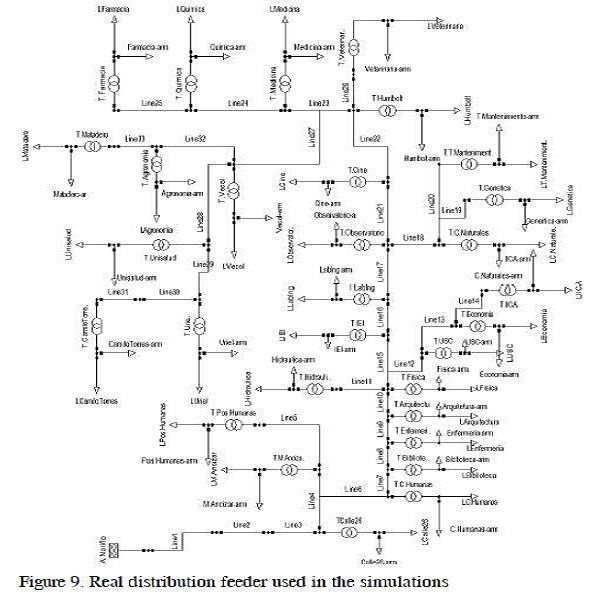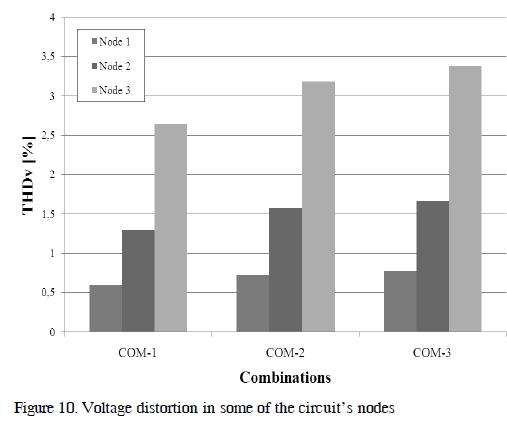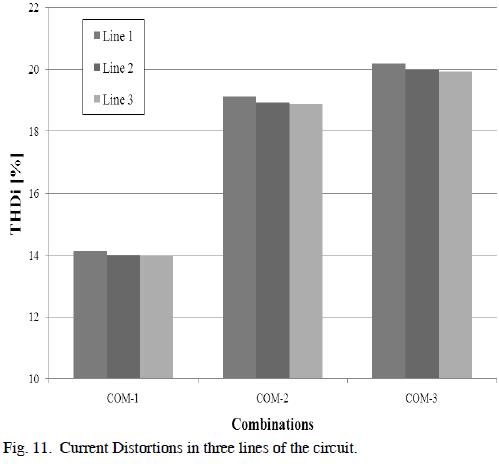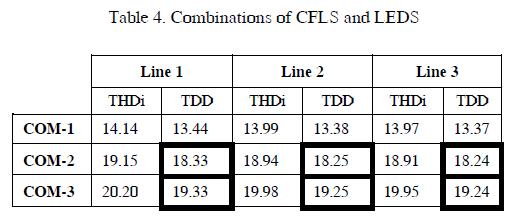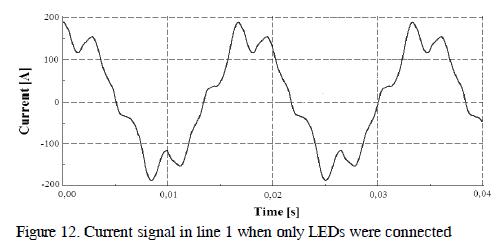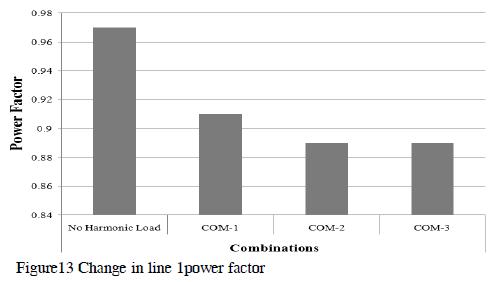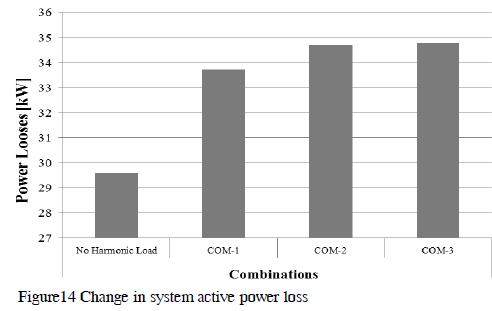Services on Demand
Journal
Article
Indicators
-
 Cited by SciELO
Cited by SciELO -
 Access statistics
Access statistics
Related links
-
 Cited by Google
Cited by Google -
 Similars in
SciELO
Similars in
SciELO -
 Similars in Google
Similars in Google
Share
Ingeniería e Investigación
Print version ISSN 0120-5609
Ing. Investig. vol.31 suppl.2 Bogotá Oct. 2011
The effects on radial distribution networks caused by replacing incandescent lamps with compact fluorescent lamps and LEDs.
Efectos sobre los circuitos de distribución causados por el reemplazo de lámparas incandescentes con bombillas fluorescentes compactas y LEDs.
A. M. Blanco1 and E. E. Parra2
1 Ana María Blanco Castañeda: Ingeniera electricista y Magister en Ingeniería Eléctrica de la Universidad Nacional de Colombia, y actualmente desarrolla sus estudios de doctorado en la Tecnische Universität Dresden en Alemania. (Correo: amblancoc@unal.edu.co)
2 Estrella Esperanza Parra: Ingeniera electricista y Magister en Ingeniería Eléctrica de la Universidad Nacional de Colombia. Es especialista en Sistemas de Potencia. (Correo: eeparral@unal.edu.co).
ABSTRACT
Compact fluorescent lamps and high-power light-emitting diodes use an electronic device that injects harmonics into distribution networks, thereby altering power quality levels. This paper shows these lamps' electrical characterisation and the results of a computer simulation of a radial distribution feeder supplying electricity to customers who use this type of harmonic load. The objective was to analyse the effect on distribution systems due to CFLs and LEDs' high penetration.Index terms: compact fluorescent lamps (CFLs), light-emitting diodes (LEDs), harmonic distortion, power quality.
RESUMEN:
Las bombillas fluorescentes compactas y los diodos emisores de luz de alta potencia usan un dispositivo electrónico que inyecta armónicos en las redes de distribución, alterando los índices de calidad de la potencia. Este artículo muestra la caracterización eléctrica de este tipo de lámparas y el resultado de la simulación de un circuito de distribución radial que alimenta a consumidores residenciales que utilizan este tipo de cargas armónicas. El objetivo es el de analizar el efecto en los sistemas de distribución debido a la alta penetración de BFCs y LEDs
Palabras Claves: Bombillas fluorescentes compactas (BFCs), diodos emisores de luz de alta potencia (LEDs), distorsión armónica, calidad de la potencia
1. Introduction
International policies for caring and preserving the environment have encouraged the use of high-efficiency technologies. The European Union, Argentina, Canada, California, Australia, the Philippines, Russia, Colombia and other countries have banned the production, import, sale and use of inefficient incandescent bulbs during the last few years and have promoted the implementation of compact fluorescent lamps (CFLs) and high-power light-emitting diodes (LEDs) in household installations.
CFLs and LEDs have a long life and high luminous efficacy, but they use an electronic device for their operation. These devices (ballasts and drivers) are nonlinear loads that inject harmonics into the electrical grid. Due to lighting consuming around 20% of the electricity generated in the United States, the European Union (Acevedo et al, 200, pp. 481-510) and many countries in the world, the massive change from incandescent bulbs to LEDs and CFLs can produce severe problems for distribution systems, such as unacceptable voltage distortion levels [3], destruction of power-factor capacitors and equipment malfunction (Watson et al, 2009, pp 1521-1528).
The main object of this paper was to analyse the effect of CFLs and LEDs' large-scale penetration of distribution systems (Blanco,2010), (Cunill et al, 2007, pp. 2305-2311). Electrical tests were performed on a group of CFLs and LEDs to characterise harmonic load. With this information, simulations were made in a real distribution circuit using DigSilent (Blanco,2010).
2. Electrical characterization
Twenty-nine CFLs samples and 43 LEDs samples from different manufactures were tested to obtain their electrical characteristics (Blanco,2010). These (current, power, power factor, distortion) and the lamps' current signals were measured according to IEC standard 60969 (IEC Standard, 2001). The following procedure was used for measuring the lamps:
- Lamps were aged for a period of 100 h of normal operation before taking the measurements;
- The test voltage was stable within ±0,5 %, during stabilization periods, this tolerance was reduced to ±0,2 % at the moment of measurements.
- The total harmonic content of the supply voltage (THDv) did not exceed 3 %. The harmonic content was defined as the r.m.s. summation of the individual harmonic components using the fundamental as 100 %.
- The test voltage was the rated voltage (120Vrms).
- Tests were carried out at rated frequency (60Hz).
- Measurements did not start before the stabilization time has elapsed. Stable operation has been reached after 15 minutes of continuous operation.
- Lamps were operated in free air in a vertical base-up position.
The circuit for measuring the bulbs was taken from the standard IESNA LM-66-00 (IESNA Standard, 2000) and is shown in Fig. 1, where a Fluke 43B power analyzer was used to measure the electrical variables and a Fluke 190b oscilloscope to obtain the voltage and current signals of the lamps.
Table I shows the results of ten selected samples, and Figures 2 and 3 illustrate voltage and current signals. Results for the full set of bulbs were similar to those shown below.
Total harmonic distortion (THD) shows percentage current (or voltage) signal distorion [4]. In line with IEEE-Std 519-1992, this factor aws defined by:
where Ck was harmonic voltage or current amplitude.
This indicator alone does not show the specific characteristics of a signal, because two signals with different harmonic content can have the same THD, but their effect on a distribution system would be different (Parra, 2004. Pp. 481-510). To complete the analysis, the harmonic content of the 10 selected samples are shown in figures 4 and 5.
According to the tests, the measured samples' CFL current signals and harmonic content were similar. This happened because the ballast used in these lamps had the same configuration for all brands. The situation was completely different for LEDs, since current signals depended on driver configuration. However, CFL and LED spectra were equivalent, having high odd harmonics, very low even harmonics, poor power factor and high THDi (around 80% to 140%).
A customer has about 5 bulbs from different manufacturers in simultaneous operation for approximately five hours daily. Using many lamps at the same time can change current signals, a phenomenon known as attenuation effect [9]. The current signals from different CFL and LED combinations were measured to recreate this scenario. The information about these combinations is given in Table 2.
The test circuit is shown in Figure 6, where a Fluke 43B power analyser and a Fluke 190b oscilloscope were used. The electrical parameters and current signals were measured using the procedure describe above.
The next table shows the results regarding the selected combinations. Figure 7 illustrates the measured voltage and current signals and Figure 8 shows the harmonic content of the different combinations' current signals.
Although several nonlinear loads were connected simultaneously, the distortion of the current signal in the 3 combinations was significant. The low values of power factor are due the considerable current harmonic content, particularly odd harmonics. The worst scenario is one in which only LEDs was used, but the combination that use CFLs and LEDs has the best response.
3. Simulations
Simulations were carried out in a real distribution feeder of Bogotá with the results obtained in the electrical characterization. The objective is estimate the effect on distribution circuits due to intensive use of CFLs and LEDs.
The circuit is shown in Fig. 9. It is a 11.4kV radial circuit, whose phases are in balance and have transformers with a Delta-Wye connection. The characteristics of lines and transformers were supplied by the local distribution company. The power consumption assumed is 2020kW, a value that is equivalent to the maximum load of the system according to the load duration curve.
The lighting load (harmonic load) was simulated as a current source with the harmonic content measured in the 3 combinations of lamps described before and this load was assumed equal to 20% of the initial system load. The simulations were carried out in DigSilent.
As expected, the power quality indices were affected with the introduction of these harmonic loads. The distortion of the voltages in the circuit was increased significantly. The figure 10 shows the values of THDv for some nodes of the circuit. Some nodes have distortions above 3% but the higher value of THDv was 3.42% where only LEDs where used (COM-3). Should be noted that the Standard IEEE-519 (IEEE Standard, 1993) limit the voltage THDv to 5% for systems below 69kV, so in these simulations all the nodes do not exceed this limit.
Likewise, the distortion of the currents in the circuit was increased. The Fig. 11 shows the current distortions (THDi)
For three different lines of the circuit. None of the in all the simulations have a distortion above 25%.
However with the values of THDi is not possible to analyze the effect on the system. To do this analysis, the values of TDD (Total Demand Distortion) were calculated according to the Standard IEEE-519 (IEEE Standard, 1993). In accordance with this standard, this factor is defined as the root mean square (rms) of the harmonics expressed as a percentage of the maximum load current magnitude:
where Ih is the amplitude of the harmonic current and I1,max is the maximum demand current magnitude at the rated frequency.
IEEE standard 519 also gives TDD limits based on the short-circuit current ratio available at the point of common coupling (PCC) to maximum fundamental load current. The feeder's load curve, maximum demand current and short-circuit current were known for this analysis, so the TDD factor was calculated.
Table 4 shows the comparison between THDi and TDD values for three different lines and the values highlighted did not fulfil the standard's limits. As a result, including CFLs and LEDs can produce unaccepted distortion in current signals. Figure 12 shows line 1's current signal when only LEDs were connected (THDi =20.20%).
The system's power factor and power losses obtained with harmonic loads were compared to the system's values without harmonic load. Figure 13 shows power factor values for line 1 and Figure 14 shows the system's power losses. As was expected, reduced power factor led to increased power loss.
4. Conclusions
Compact Fluorescent Lamps and Light Emitting Diodes are the lighting technologies which will replace traditional incandescent bulbs. These technologies are energy efficient products, but are characterised by having very low power factors (around 0.5) and high current harmonic distortions (80% to 150%).
According to simulations, the widespread use of LEDs and CFLs will increase the voltage and current distortion in distribution networks. In an ordinary distribution circuit (radial and with balanced phases), asubstitution will not cause serious changes in voltage signals, but current signals could have unaccepted distortion. Moreover, the simulations showed increased active power losses. This was due to the appearance of high harmonic currents circulating through the system's elements.
High CFL and LEDs penetration of distribution networks could produce unaccepted distortion and low power factors which should be considered. Stricter standards are needed to prevent future distribution networks problems.
5. References
Acevedo, I. L; Morgan, G. and Morgan, F. ''The Transition to Solid-State Lighting'' Procedigs of the IEEE, vol. 97, no. 3, pp.481-510, Mar. 2009. [ Links ]
Blanco, A.M. "Efecto sobre los circuitos de distribución secundarios debido al uso intensivo de Bombillas Fluorescentes Compactas y LEDs (Light Emitting Diodes),'' M.Sc. dissertation, Dept. of Electrical Eng., National University of Colombia, Bogotá, 2010. [ Links ]
Blanco, A.M; Parra, E. ''Effects of High Penetration of CFLs and LEDs on the Distribution Networks,'' in the 14th International Conference on Harmonics and Quality of Power 2010, pp.1-5 [ Links ]
Cunill-Solà J. and Salichs, M. ''Study and Characterization of Waveforms From Low-Watt (<25W) Compact Fluorescent Lamps With Electronic Ballasts,'' IEEE Trans. Power Delivery, vol. 22, no. 4, pp 2305-2311, Oct. 2007. [ Links ]
IEC Standard Self-ballasted lamps for general lighting services - Performance requirements, IEC Standard 60969, Mar. 2001. [ Links ]
IEEE Recommended Practices and Requirements for Harmonic Control in Electrical Power Systems, IEEE Standard 519-1992, Apr. 1993. [ Links ]
IESNA, Approved thod for the electrical and photometric measurements of single -ended Compact Fluorescent Lamps, IESNA Standard LM-66-00. 2000 [ Links ]
Nassif A.B. and Acharya, J. ''An Investigation on the Harmonic Attenuation Effect of Modern Compact Fluorescent Lamps,'' in the 13th International Conference on Harmonics and Quality of Power 2008, pp.1-6. [ Links ]
Watson, N. R; Scott, T. and Hirsch, S. ''Implications for Distribution Networks of High Penetration of Compact Fluorescent Lamps,'' IEEE Trans. Power Delivery, vol. 24, No. 3, pp. 1521-1528, July 2009. [ Links ]













